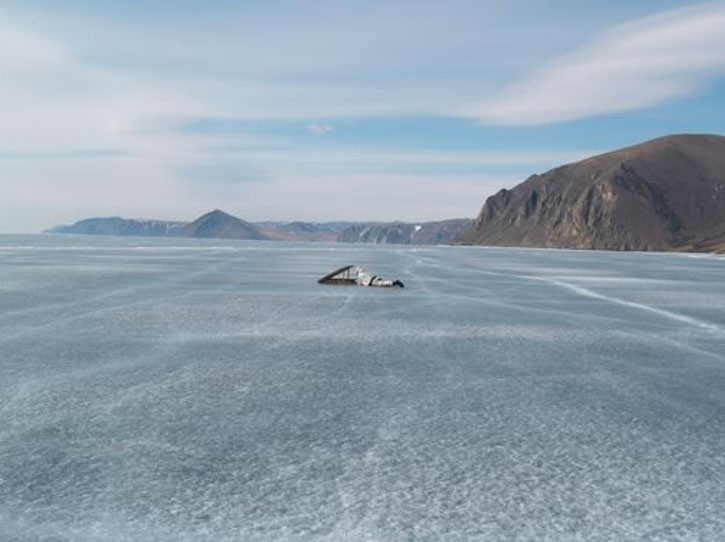NyArktis takes as its starting point the 'Arctic Domestication in the Era of the Anthropocene' (http://cas.oslo.no), a project that challenges the great western Civilisation narrative. This narrative describes agriculture and animal domestication as the foundation of our civilization, the origins of complex societies, division of labour and hierarchical relations.

This exhibition explores the consequences of the foundational story for the Arctic. We wish to display how this narrative categorises Arctic peoples as uncilivilised, the Arctic landscape as an open, untouched wilderness available for resource exploitation: A place to be discovered, explored and civilized (or domesticated) by the white European male. In this landscape, hunters, trappers and gold miners have been followed by missionaries and scientists, and later geologists and global investors.

This exhibition explores the consequences of the foundational story for the Arctic. We wish to display how this narrative categorises Arctic peoples as uncilivilised, the Arctic landscape as an open, untouched wilderness available for resource exploitation: A place to be discovered, explored and civilized (or domesticated) by the white European male. In this landscape, hunters, trappers and gold miners have been followed by missionaries and scientists, and later geologists and global investors.

By using the Arctic as a starting point, NyArktis contributes to a redefinition of domestication. Here, we find relations between humans, animals and landscape with similar continuities, providing a predictable livelihood, but in ways that often are ignored.

How can we put the another Arctic history on display? In our effort to re-examin Arctic human animal relations, we find relations between humans, animals and landscape with similar continuities, providing a predictable livelihood. These again, are part of complex political structures, trade relations and other kinds of uses and understandings of rights to land and waters.
NyArktis is open in the Red Zone between the 29. april and 12. june. Come and learn more about what the Arctic can be.

Arctic Domestication in the Era of the Anthropocene, at Centre for Advanced Studies, Norwegian Academy of Sciences and Letters (CAS). NyArktis draws on several academics disciplines and insights from a group of researchers, including Marianne Lien, Liv Østmo, Britt Kramvig, Natasha Fijn, Rob Losey, Heather Swanson, Nancy Wachowich, John Law, Berit Kristoffersen, Sverker Sörlin and Gro Ween. Academic project leader is Gro Ween, while aesthetic project leader is architect Åsmund Steinsholm.
Thanks
Arctic Domestication would like to thank the Cultural History Museum for the opportunity to use its Red Zone. At the museum, we would particularly like to thank Inge Bjøren, Johnny Kreutz, Ragnar Løchen, Tone Cecilie Simonsen Karlgård, Kirsten Helgeland, Martin Hager-Saltnes, Torunn Klokkernes, Margunn Veseth, Eili Lindøe, Ellen Semb, Bjørn Vidar Johansen, Farideh Faramazi, Ralfs Znotins, and last but not least Tone Wang and Tom G. Svensson. Outside the museum, we are particularly grateful to Liv Østmo, Anja Somby, Jon Andreas Utsi, Karen Ellen Marie Siri Utsi,Inga Anne Maret Juuso, Rachel Gomez, Geir Tore Holm, Ellen Triumf, Margrethe Iren Pettersen, Karen Elle Gaup, Nina Hermansen, Anders Bache, Hans Arne Nakrem, Nancy Wachowich, Melisa Andrea Costinea, Maria Kartveit, Alexander Svingen and Mathilde Engen Stabekk. Films shown in the ceiling are excerpts from Aatsinki. The Story of Arctic Cowboys by Jessica Oreck, Myriapod Productions LLC, and Dreamland, by Britt Kramvig and Rachel Gomez in Sonar Film. Short films are Reindeer, by Eva Weber of Odd Girl Out Productions, and Moving with the Reindeer in the Winter by Jan Helmer Olsen. Films show non Ipads in the tent are made by Liv Østmo, Rob Losey, and Mittimatalik Arnait Miqsuqtuit Collective. The exhibition soundscape is Levende land Under som Over by Margrethe Pettersen, with music made by Christian Hollingsæter. Geir Tore Holm’s sculpture Omasum is displayed together with the dried reindeer stomach preserved by Jon Andreas Utsi and Karen Ellen Marie Siri Utsi. The exhibition is made with support from KHM, CAS, and Johannes Falkenberg foundation, as well as Mobilizing Inuit Cultural Heritage (SSHRC, York University, Canada) financing the Mittimatalik Arnait Miqsuqtuit Collective, consisting of Nancy Wachowich, Gro Ween, Sheila Katsak, Skylar Katsak, Leah Kippomee, Amy Kippomee and Melisa Costinea.

